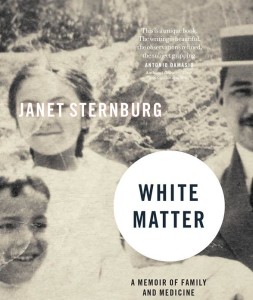 white mat·ter noun 1. the brain’s switchboard between thinking and feeling
white mat·ter noun 1. the brain’s switchboard between thinking and feeling
Told with unflinching honesty, White Matter: A Memoir of Family and Medicine is the story of a close-knit Boston Jewish family of five sisters and one brother and the devastating consequences of the medical decisions they made to keep the family together after being abandoned by their father. When Sternburg’s uncle Bennie became increasingly mentally ill, his sisters decided in the late 1930s that he should undergo a lobotomy to treat his schizophrenia. Later, their youngest sister, Francie, would endure the same procedure in the hope it would cure her debilitating depression. Today, surgery to disconnect the brain’s “white matter,” leaving a person without feelings, seems inconceivable.
Woven into Sternburg’s memoir are notable figures that influenced the family as well as the entire medical field: Abraham Myerson, inventor of the first anti-depressant, Alexandra Adler, daughter of Alfred Adler, who pioneered the concept of post-traumatic stress disorder, Antonio Egas Moniz, who was awarded the Nobel Prize in Medicine in 1949 for developing the lobotomy, and Walter Freeman, who developed an alternate technique for lobotomy, which he proselytized during his travels throughout the country in a van he dubbed the “Lobotomobile.”
Sternburg writes as a daughter consumed with questions about her mother and aunts — all well-meaning women who decided their siblings’ mental health issues would be best treated with lobotomies. By the late 1970s, the surgical practice was almost completely out of favor, but its effects left patients and their families with complicated legacies as well as a stain on American medical history. Every generation has to make its own medical choices based on knowledge that will inevitably come to seem inadequate in the future. But how do we live with our choices once we see the consequences?




